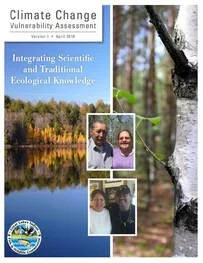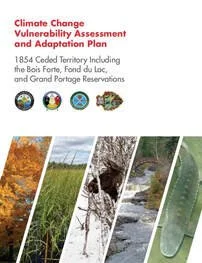
MANOOMIN
(WILD RICE)
CLIMATE CHANGE LITERATURE
Throughout 2019, the following published literature was reviewed to better understand how climate change impacts manoomin across the Great Lakes Region.
Scientific Publications
Mature wild rice (Z. palustris) plants were collected and measured from 20 different fertilizer and pesticide free sites throughout the four seasons from 1984 through 1987 in northern Saskatchewan. To determine the variation among environmental factors, plants growing in natural, unmanaged settings were compared to those planted in controlled growth tanks. According to the data, Z. palustris productivity in natural habitats proved to be more sensitive to environmental stressors such as wave action, flooding, and extreme temperatures. Research sites in western Saskatchewan produced the thickest stems, largest seed heads, and the most hearty wild rice stands in 1984. However, flooding the following year decimated most of the plants. Some stand densities experienced a 33% reduction while others completely failed to develop. In 1985, researchers were unable to harvest seeds from any of their 20 sites across Saskatchewan due to flooding and stunted growth rates. Sites to the west still impacted by flooding in 1986 did not recover well; observations of decreased floret numbers, stem length, and stem diameter were recorded. According to the data recorded in 1987, wild rice plants began returning back to the healthy observations seen three years earlier.
The purpose of this PowerPoint is to educate the audience about the traditional ecological knowledge of indigenous peoples, and how climate change will impact the culturally significant manoomin (wild rice) beds across the Great Lakes area. After their introductory slide, the authors provide photos and maps indicating manoomin habitats and the shrinking numbers of wild rice beds. The following slides describe climate-change-induced seasonal changes predicted to negatively impact manoomin. These impacts include rising winter and summer temperatures, severe flooding from increased winter and spring precipitation, summer droughts, expansion of invasive species and fungal disease, and lower oxygen levels. Information regarding interviews conducted within the Native community indicate that elders hold cultural and historical knowledge about ricing traditions and Native sovereignty, which they hope to pass onto younger generations. As explained within the presentation, Native youth have a better scientific understanding of climate change, but tend not to be practitioners of cultural traditions. The concluding slides explain how wild rice restoration and climate change adaptation can be better implemented through, “knowledge building, regulatory protection, education and outreach, and coalition building and collaboration.”
Cheruvelil, Jubin & Barton, Barbara. Wild Rice Adaptation to Climate Change (2014).
Researchers recognize the cultural and dietary importance of manoomin (wild rice) to Anishinaabe communities throughout the Upper Great Lakes Region, and stress that climate change adaptation strategies are essential for maintaining the centuries old harvesting practices of the tribe. Based upon the predicted negative impacts climate change will have on wild rice, scientists collaborated with the Lac Vieux Desert Band of Lake Superior Chippewa (LVD) to propose a restoration and adaptation project with a clear set of seven goals which include: studying wild rice, working with tribal citizens to gain traditional knowledge, establishing partnerships with other native and non-native communities and organizations, developing and implementing manoomin management strategies, and maintaining wild rice beds. Researchers discuss the ecological history and benefits of wild rice, give detailed examples of climate change impacts, and express the cultural and economic concerns of tribal communities. As recommended within the study, the LVD community can best manage restoration efforts by researching, securing ecological services and resources, exercising Native sovereignty to enforce legal protections of manoomin, providing education and outreach opportunities, and networking to expand collaborations with stakeholders and other institutions.
Scientists reviewed studies comparing individual plants of the same seven species growing at different latitudinal points in both natural and garden settings in order to gain an understanding of the impact climate change has on vegetation. Globally, a decrease in biodiversity ranging from the tropics to the poles has been observed. Researchers suggest the decline among plants may be a result of newly developed defense adaptations in higher latitudes, such as leaf loss in severe environments and pathogen defenses. The article explains that declining biodiversity in North America can be attributed mainly to habitat loss through human impact, and how habitat loss in areas experiencing increased temperatures can intensify the effects of climate change. Mean annual temperatures (MAT) in North America change more quickly with latitude than other regions of equal latitude on Earth. The authors note that prolonged snow cover due to seasonal shifts in the higher latitudes of North America create thermal isolation which stunt the growth and survival of shorter vegetation.
Japanese researchers performed experiments on wild rice plants in a controlled glasshouse setting to observe the effects of temperature and water depth on growth stages of the plants. By conducting these tests, researchers hoped to gain a better understanding of how to begin commercialized cultivation of wild rice in Japan, and prove that genetic modification of rice species already growing in Japan may be valuable. According to the article, Z. palustris' genetic value comes from the plant's ability to adapt to colder environments and their extremely high levels of amino acids. Data presented in the experiments demonstrate that wild rice is affected by both temperature and water depth during seedling development. Plants kept at water depths 2-6 cm with temperatures ranging from 15-20°C produced the best results. Any fluctuation beyond these parameters resulted in reduced dry weight measurements, as well as morphological changes such as the development of an “exhausted phenotype” among the wild rice plants.
Composers of this online learning tool created a section providing readers with information regarding the history and habitat of manoomin (wild rice), as well as ways in which climate change is impacting the region. As explained within this piece, manoomin is an ancient, sacred ceremonial crop that remains a dietary staple of Ojibwes and wildlife within the Great Lakes region. The authors illustrate the symbiotic relationship between indigenous communities and manoomin by describing traditional harvesting methods in which rice is harvested into canoes while some kernels are allowed to fall back into the water, ensuring new growth for future generations. Manoomin requires shallow waters with minimal wave action, especially during its early-summer "floating leaf" stage when it's highly vulnerable to environmental stressors. According to the tool, drought and flooding cause die-off throughout rice beds, and invasive plant species engulf critical manoomin habitats. Increasing temperatures and moisture due to climate change also promote brown spot disease, and increase damaging “rice worm” populations. As climate change and habitat loss due to land development intensify, tribal governments and organizations have implemented restoration efforts.
Oelke, E.A. et al. Alternative Field Crops Manual: Wild Rice (1992).
In this chapter from the Alternative Field Crops Manual, scientists explain the history, production, and environmental requirements and habitat of wild rice. They state that wild rice is a nutritious grain native to North America, traditionally grown in shallow natural waters and harvested by indigenous tribes throughout the Great Lakes region. Since colonization, farmers have domesticated the crop by converting lands into rice paddies for mechanical harvesting and mass production, and genetically modifying seeds to be more shatter-resistant. Researchers explain that wild rice plants experience stunted growth and morphological changes when exposed to high temperatures and drought, indicating that the plants are adapted to northern latitudes. They also state that flooding causes the plants to weaken, and in some cases the plants may be uprooted if water flow is high. According to the article, wild rice is more susceptible to brown spot disease when temperatures during the day range from 74° to 95°F, during continuous flooding, and when relative humidity is higher than 89%. Other threats to wild rice induced by flooding include increased populations of crayfish, midges, and rice worms.
Within this assessment, the authors address how climate change is impacting Ojibwe communities and the environment within the Great Lakes region, and how Traditional Ecological Knowledge (TEK) and Scientific Ecological Knowledge (SEK) can together be used to implement climate change adaptation and conservation efforts. To gain an understanding of how to better address climate change within Native communities, scientists and TEK experts interviewed citizens of the Ojibwe nation and performed vulnerability assessments of key species and beings within their territories. According to the assessment, manoomin ( northern wild rice) is the most vulnerable species, and has a vulnerability score ranging from 27-30, with 32 being the highest score possible. Manoomin grows best in shallow waters with soft sediment and minimal water flow, and is highly sensitive to environmental stressors amplified by climate change. Authors of the report provide a summary of the main concerns expressed by tribal members, which include manoomin habitat loss due to dam construction, invasive species such as carp, infections of brown spot disease, increasingly severe and damaging weather events, drastic fluctuations in water levels, and pollution. Researchers included additional climate change impacts to the assessment and ranked these effects according to their likelihood of increasing species vulnerability.
Conservation and restoration projects for wild rice species with reduced size and gene flow can be improved by studying where the plants originate and which aquatic environments they thrive in. In this study, scientists performed water depth and seed provenance experiments on wild rice (Z. aquatica L.) seeds harvested from three different wild rice stands in Indiana during the fall of 2008. The seeds were germinated and grown in a controlled greenhouse with temperatures ranging from 19-28°C, and were provided with both natural and artificial lighting. Water depth treatments included a drought treatment in which plants were watered every ten days, and complete saturation at depths of 0 cm, 23 cm and 46 cm. According to the data, dry weights (total and component) and plant height were greater for wild rice grown at the water’s surface than any of the other treatments. Researchers compared their results with Zizania palustris L. data to determine that Z. aquatica responds differently to water depth. As explained within the study, communities and organizations working to restore wild rice stands should concentrate on maintaining optimal water depths specific for the species in their area, and limit competition for sunlight from other aquatic species until the rice is “well established.”



